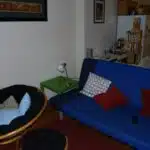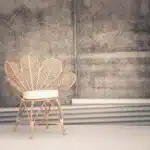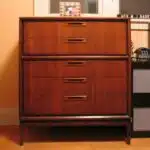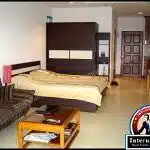Properly measuring a space for furniture is an essential step in any interior design project. It ensures that the furniture will fit comfortably and functionally within the room’s layout, making the space more inviting and functional. As an interior design consultant, I have seen countless instances where inadequate measurements led to costly mistakes, resulting in ill-fitting pieces or cluttered rooms.
The process of measuring a space for furniture may seem straightforward, but it requires precision and attention to detail. Factors such as ceiling height, doorways, windows, and architectural elements must be taken into consideration to ensure that the furniture complements the room’s overall aesthetic while also providing practical usage. In this article, I will provide a comprehensive guide on how to properly measure a space for furniture that will help you achieve your desired look and function while avoiding costly mistakes.
Understanding The Importance Of Accurate Measurements
Measuring a space accurately is of utmost importance when it comes to furnishing your home. The precision of your measurements will ultimately determine how well the furniture fits in the designated area. Inaccurate measurements can have a significant impact on the overall aesthetics and functionality of the room. Therefore, it is crucial to ensure that you measure your space with great care and attention to detail.
When you take precise measurements, you can be sure that the furniture you purchase will fit perfectly in your space without causing any issues. If there are inaccuracies in your measurements, then you may end up with furniture that is too big or small for the room, which could lead to unnecessary clutter or an unsightly and awkward layout. In addition, inaccurate measurements may also result in a less functional living space.
It’s important to understand that taking accurate measurements isn’t just about ensuring that everything fits together nicely; it’s also about creating an inviting and aesthetically pleasing environment. When done correctly, measuring your space can help you identify potential design opportunities and highlight areas where improvements can be made. Accurate measurements are critical for creating a comfortable and stylish living area that reflects your personality and style preferences. Now, let’s move on to gathering the necessary tools required for this task.
Gathering The Necessary Tools
Selecting appropriate tools is essential to ensure accurate measurements when preparing a space for furniture. The most important tool you need is a measuring tape, which can be found at any hardware store or home improvement center. A metal tape measure that is at least 25 feet long with a locking mechanism will provide more precise measurements than a cloth tape measure.
To take accurate measurements, it’s important to follow a few tips. When measuring the length of a wall, start from one corner and work your way to the other end. Make sure the tape measure stays level and straight as you move along the wall. For width measurements, start from one side of the room and extend the tape measure across to the opposite wall. Always double-check your measurements before recording them.
By selecting appropriate tools and following these tips for taking accurate measurements, you’ll have a solid foundation for creating an optimal layout for your space. However, it’s important to keep in mind that gathering tools and taking measurements are just the first steps in this process. The next section will cover how to prepare your space for measuring by removing obstacles and ensuring proper lighting.
Preparing The Space For Measuring
An important step in measuring a space for furniture is preparing the area. This process involves clearing clutter and choosing a measuring partner. A recent study shows that more than 50% of homeowners struggle to properly measure their living spaces due to poor preparation.
To clear clutter, start by removing any unnecessary items from the space being measured. This includes furniture, decor, and personal belongings. By having a clear and open area, it will be easier to take accurate measurements without obstacles in the way. Choosing a measuring partner can also help ensure accuracy and efficiency in the process.
Here are four tips for preparing the space for measuring:
- Remove all unnecessary items from the space
- Clean the area to eliminate any dust or debris
- Ensure proper lighting is available for accurate measurements
- Choose a measuring partner to assist with taking measurements
By following these steps, you can set yourself up for success in accurately measuring your space for furniture placement. Next, we will discuss how to measure the room’s width to ensure proper furniture fit.
Measuring The Room’s Width
Properly measuring a room’s width is crucial when planning furniture layouts. It ensures that your furniture fits perfectly, and there is enough space to move around without feeling cramped. The most common tool used for measuring a room’s width is a measuring tape. However, if you do not have one, there are other measuring tape alternatives that you can use.
One alternative to using a measuring tape is using a yardstick or ruler. This option works best for smaller rooms as it may be difficult to measure larger spaces with this method. Another alternative is using your feet to measure the length of the wall and counting the number of steps it takes until you reach the end of the wall. This method may not be as accurate as using a measuring tape but can still provide an estimate.
Measuring irregularly shaped rooms can also be challenging but can be done with precision if done correctly. Start by breaking down the room into smaller shapes such as rectangles and triangles, then measure each shape individually. Finally, add up all the measurements to get the total width of the room. By doing this, you will get an accurate measurement regardless of how irregularly shaped your room may be.
When it comes to measuring a room’s width, there are different methods you can use depending on what tools you have available or how irregularly shaped your space may be. Now that we have discussed how to measure the width let us move on to our next section – Measuring The Room’s Length – where we will discuss another important aspect in determining furniture placement in any given space.
Measuring The Room’s Length
When designing a room, it is crucial to ensure that furniture fits comfortably and does not clutter the space. Measuring the room’s length should be the first step in creating a functional and visually appealing layout. Before measuring, it is essential to gather all of the necessary tools, including a measuring tape or its alternatives.
Measuring tape alternatives such as yardsticks or rulers can be used if you do not have access to a traditional measuring tape. However, it is important to note that these alternatives may not be as accurate and could lead to measurement errors. It is recommended to invest in a quality measuring tape for more precise measurements.
Additionally, when measuring the room’s length, it is crucial to factor in the dimensions of any furniture you plan on placing in the space. This will help you determine how much distance needs to be left between each piece of furniture and ensure that there is enough room for movement around the room. Failing to measure furniture dimensions may result in overcrowding or underutilization of available space.
Next up is measuring the room’s height. This will help determine how high shelves can be placed on walls and what kind of light fixtures can be installed. Keep reading to learn about this next step!
Measuring The Room’s Height
One essential factor to consider when measuring a room for furniture is the ceiling height. Measuring ceiling height will help you estimate the size of furniture that would be suitable for your space. Therefore, it is essential to measure the height of each wall in the room.
Start your measurement by standing at one corner of the room and use a tape measure to get an accurate reading from the floor to the ceiling. Repeat this process for all four corners of the room, as walls may not have equal heights. After getting measurements from all corners, calculate their average to get an accurate estimation of your room’s ceiling height.
Here are some tips to guide you while measuring your room’s height:
- Ensure that your tape measure is straight before taking any readings
- Measure each corner twice or more to ensure accuracy
- Round up odd measurements to half-inch or inch increments
- Record all measurements on paper and carry out calculations later on
- Take note of any molding or trim along walls as they can affect furniture placement.
Identifying Obstacles and Architectural Elements
Now that you have measured your room’s height and estimated suitable furniture sizes, it is essential to identify any obstacles or architectural elements that may affect furniture placement. These elements include doors, windows, columns, light fixtures, and fireplaces. Identifying these features will help you create a functional design plan that considers both aesthetics and functionality.
For instance, if there is a window on one wall, it may limit where you can place furniture such as a sofa or bed frame. Similarly, if there are columns in the middle of a large living area, they may affect where you place seating arrangements. By identifying these obstacles beforehand, you can plan accordingly and make sound decisions when selecting furniture pieces.
In summary, measuring ceiling height is an important step in creating a functional interior design plan. Once completed successfully, it helps estimate suitable furniture sizes for your space. Identifying obstacles and architectural elements is another crucial step in creating an overall functional design plan that considers both aesthetics and functionality.
Identifying Obstacles And Architectural Elements
Identifying obstacles and architectural features is an essential step when measuring a space for furniture. Obstacles such as pillars, posts, or built-in shelves can greatly affect the placement of furniture. It is important to take note of their height, width, and depth to prevent unwanted collisions with furniture pieces. On the other hand, identifying architectural elements like doorways, windows, or crown moldings can also affect the arrangement of furniture and decor within a space.
When measuring around furniture or decor, it is necessary to measure from the farthest point of each item. This allows sufficient clearance between each piece and prevents overcrowding in a room. Additionally, considering the proportions of furniture in relation to wall space can help create balance and harmony within a room.
Overall, taking note of obstacles and architectural features during measurement can save time and effort in rearranging furniture pieces later on. A thorough understanding of these elements allows for efficient use of space and creates a functional layout that suits the needs and preferences of clients.
Transition: Now that we have identified potential obstructions in our space, let us move on to measuring doorways and windows for optimal furniture placement.
Measuring Doorways And Windows
After identifying obstacles and architectural elements in a space, the next step is to measure doorways and windows. Measuring doorway width is crucial to ensure that furniture can fit through them during delivery. It’s important to measure the width at three locations – the top, middle, and bottom – as doorways can be narrower at certain points due to molding or other obstructions.
Measuring window height is also essential when selecting furniture for a space. The height of a window determines how tall furniture can be without obstructing natural light or views. Measure from the floor to the bottom of the window frame, as well as from the floor to the top of the frame, and consider any additional clearance needed for curtains or blinds.
By accurately measuring doorways and windows, interior design consultants can select furniture that fits perfectly within a space without causing any delivery or installation issues. In the next section, we will discuss how to measure existing furniture in order to determine if it will fit within a new space. Understanding these measurements will help you make informed decisions on what furniture pieces are best suited for your space while allowing you to create an aesthetically pleasing and functional environment.
Measuring Existing Furniture
Did you know that one of the most common mistakes people make when buying furniture is not measuring their space correctly? According to a survey conducted by Houzz, over 30% of homeowners have purchased furniture that was too big for their room. This can lead to a cluttered and cramped living space, which is far from ideal. To avoid this issue, it is crucial to accurately measure your space before purchasing any furniture.
Measuring existing furniture can be helpful when trying to determine what size and style of furniture will work best in your space. Start by measuring the dimensions of your current pieces and note how they fit in the room. This will give you an idea of what size furniture you need for each area. Be sure to also measure any doorways or hallways that the furniture will need to pass through during delivery.
When selecting appropriate furniture sizes, keep in mind the scale of the room. Large pieces can overwhelm a small space and make it feel even smaller, while small pieces may get lost in a large room. Consider creating a focal point with a larger piece and balancing it out with smaller complementary pieces around the room. Additionally, consider the function of the room and how much traffic it gets. A crowded family room may require more seating options than a formal sitting area.
To summarize, measuring furniture dimensions and selecting appropriate sizes are crucial steps when furnishing your home. Remember to measure both your space and existing furniture before purchasing anything new, and keep scale and function in mind when selecting pieces. In the next section, we will discuss how to create a floor plan for your newly measured space without making any costly mistakes.
Creating A Floor Plan
Measuring existing furniture is only the first step in creating a functional and aesthetically pleasing space. The next important step is to create a floor plan that accurately represents the measurements of your room. This will help you visualize how your furniture will fit in the space and ensure that you are making the most of every square inch.
One helpful tool for creating a floor plan is color coding. Use different colors to represent different types of furniture or areas of the room, such as seating, storage, and workspaces. This can help you see how each piece relates to the overall layout and identify any potential issues before you start moving heavy furniture around.
In addition to traditional methods such as graph paper and a pencil, there are now many virtual tools available online that can assist with creating a floor plan. Some programs even allow you to upload a photo of your room and add virtual furniture to see how it would look in real life. These tools can save time and eliminate guesswork when planning your space.
Now that you have an accurate floor plan, it’s time to choose furniture that fits your space. This requires careful consideration of not only size but also style, color, and functionality. Keep in mind any limitations or challenges posed by your floor plan, such as low ceilings or limited natural light. With these factors in mind, you can select pieces that not only fit well but also enhance the overall design of your space.
Choosing Furniture That Fits Your Space
- Accurately measuring furniture is essential when looking to purchase furniture to fit within a space.
- Space planning is a critical factor when selecting furniture, as it can help determine the number of pieces and the size of each piece that will comfortably fit into the room.
- It is important to consider the shape of the room, the amount of traffic and the purpose of the room when space planning.
- Measurements should be taken of both the furniture and the space to ensure a proper fit before making a purchase.
Measuring Furniture
Accurate measurement is essential for furniture placement. Before purchasing any piece of furniture, it is important to measure the space where it will be placed. Measuring accuracy is crucial in ensuring that the furniture fits perfectly with enough room for easy movement and other accessories.
One common error when measuring furniture is not considering the angles of the space. The corners of a room are often not perfectly squared, so it is important to measure from all angles to ensure that you have accurate measurements. Another common mistake is not taking into account the height of the ceiling or doorway when selecting taller pieces such as bookshelves or armoires. Always take into consideration these factors before making a purchase.
When measuring for furniture, remember to always double-check your measurements and compare them with those provided by manufacturers. Take note of any potential obstacles such as protruding baseboards, light fixtures, or vents that could affect placement or size requirements. By doing this, errors can be minimized and you will be able to make informed decisions about what pieces will fit comfortably in your space while also allowing for optimal functionality and design aesthetic.
Space Planning
Maximizing space is a crucial element in interior design, especially when choosing furniture that fits your space. Space planning involves not only determining the size of furniture but also its arrangement to create an efficient and functional layout. As an interior design consultant, it is my job to ensure that every piece of furniture chosen for a client’s home maximizes their available space while maintaining aesthetic appeal.
When planning the layout of a room, consider the traffic flow and how people will move around the space. The placement of furniture should be such that movement is easy and unobstructed. It is essential to leave enough room between pieces to allow for comfortable movement while still maximizing the available floor area. By doing so, you can create a functional environment that feels open and spacious without sacrificing style or comfort.
The arrangement of furniture in a room can significantly impact how spacious it feels. Placing larger pieces against walls and away from doorways creates visual space, making the room feel more open. Additionally, using multi-functional pieces such as storage ottomans or convertible sofas can help save valuable floor space while still providing functionality. With careful consideration to furniture placement and selection, any space can be transformed into a comfortable and practical living area without compromising on style or function.
Choosing Furniture That Complements Your Style
When it comes to choosing furniture that complements your style, there are a few key factors to keep in mind. One of the most important considerations is mixing patterns. While it can be tempting to stick with one pattern throughout a room, this can create a flat and uninspiring look. Instead, mix different patterns together to create a visually engaging space. For example, you might pair a striped rug with floral curtains or use a plaid throw pillow on a solid-colored sofa.
Another key element of creating a cohesive look for your space is choosing the right color palette. When selecting furniture pieces, consider the colors that already exist in the room and choose complementary shades that will help tie everything together. You might also want to choose one or two accent colors that can be used throughout the space in smaller decor items such as throw pillows or wall art.
By taking the time to mix patterns and choose a cohesive color palette, you can create a beautiful and personalized space that truly reflects your unique style. In the next section, we’ll explore some furniture placement tips for optimal functionality so that you can make the most of your new furniture pieces.
Furniture Placement Tips For Optimal Functionality
Measuring a space for furniture is a crucial first step in creating an optimal room layout. Traffic flow should be taken into account when considering the placement of furniture. Additionally, the overall layout and scale of the room should be taken into account. Lighting, ergonomics, and storage needs should also be taken into consideration when determining furniture placement. Additionally, personal taste in regards to color, texture, and materials should be taken into account. Finally, any budget limitations should be taken into account to ensure the best possible placement of furniture.
Measure For Size
When it comes to furniture placement, measuring your space accurately is crucial. Measuring techniques may differ depending on the shape and size of the room, but some general tips can help you get started. First, use a tape measure to measure the length and width of the room. Then, take note of any permanent fixtures, such as doors or windows, that may affect where furniture can be placed. Finally, consider the traffic flow in the room and make sure there is enough space for people to move around comfortably.
Troubleshooting tips are also important when measuring for furniture placement. For example, if you have an oddly shaped room or an area with low ceilings, you may need to get creative with your furniture choices. In smaller spaces, it’s important to choose pieces that won’t overwhelm the room and leave enough space for movement. Additionally, be mindful of how much natural light enters the room as this can affect how colors appear on your furniture.
Overall, taking accurate measurements and troubleshooting potential issues are essential steps in achieving optimal functionality in your space. By following these simple tips and tricks, you’ll be well on your way to creating a functional and stylish living area that suits your needs perfectly. Remember to take your time when measuring and don’t hesitate to consult with a professional interior designer if needed.
Traffic Flow
Optimizing the layout of a room is essential to ensure maximum functionality and visual appeal. One crucial aspect of this process is considering traffic flow and how furniture placement can affect movement within the space. When arranging furniture, it’s important to create a clear path for people to move around without obstruction. This involves taking into account the location of doors, windows, and other permanent fixtures in the room.
To achieve optimal traffic flow, consider creating designated areas within the room for specific activities. For example, if you have a living room that doubles as a workspace, try separating the two areas with a rug or piece of furniture to visually define each space. Additionally, be mindful of how furniture size and placement can impact traffic flow. Avoid overcrowding the area with too many pieces or placing them in such a way that they obstruct movement.
Creating focal points within the space can also enhance its design while optimizing traffic flow. Focal points are elements that draw attention and serve as a centerpiece in the room. Utilizing furniture and decor strategically can help create these focal points while also improving traffic flow. For instance, placing a statement piece of art above a sofa not only draws attention but also creates an anchor point in the space. By taking into account both traffic flow and focal points when arranging furniture, you can achieve an optimal layout that enhances both functionality and aesthetics.
Consider Layout
When it comes to furniture placement, considering layout is a crucial aspect to optimize functionality. Layout considerations involve taking into account the physical space of the room, traffic flow, and focal points. Furniture arrangement techniques can significantly affect how people move around within the space and how they interact with furniture pieces.
To achieve optimal functionality, it’s essential to consider layout when arranging furniture in a room. You must first assess the available space and take note of permanent fixtures such as doors and windows. This will help you determine the ideal placement for each piece of furniture in the room. Additionally, creating designated areas for specific activities can help improve traffic flow while optimizing functionality. By separating workspaces from relaxing areas or entertainment sections, you create a clear path for people to move around without obstruction.
Incorporating focal points into your design can also enhance your layout while improving functionality. Focal points draw attention and serve as an anchor point in a room. When arranging furniture, consider placing statement pieces strategically to create these focal points while still maintaining an optimal traffic flow. Designing spaces that are both functional and aesthetically pleasing requires careful consideration of layout considerations and furniture arrangement techniques.
Common Measuring Mistakes To Avoid
Avoiding mismeasurements is crucial when it comes to furniture placement. Measuring a space accurately is the first step toward transforming it into a functional and aesthetically pleasing area. However, many people make common measuring mistakes that can lead to costly errors in furniture size and placement.
To ensure accurate measurements, there are several tips for avoiding mismeasurements. Firstly, it is important to always use a reliable measuring tape or laser measure. Secondly, avoid rounding up or down to the nearest whole number as this can result in significant measurement discrepancies. Finally, always double-check your measurements before making any purchases or beginning any installations.
Here are three tips for accurate measurements:
- Always measure from wall to wall rather than from baseboard to baseboard.
- Take note of any protruding fixtures such as radiators or molding that may affect your measurements.
- Measure the height of the room at multiple points as the floor and ceiling may not be level.
By following these guidelines for accurate measurement, you can avoid wasting time and money on incorrect furniture purchases or improper placement. However, for complex spaces with unique architectural features or non-standard layouts, it may be beneficial to consider hiring a professional interior designer.
Hiring A Professional For Complex Spaces
Common measuring mistakes can lead to furniture that is too large or too small for a space, resulting in poor functionality and aesthetics. However, sometimes spaces are complex and require additional expertise to ensure proper measurements. In these cases, hiring a professional interior designer or architect can be highly beneficial.
One of the main benefits of hiring a professional is their expertise in analyzing complex spaces. They have extensive knowledge about architectural features, such as load-bearing walls and electrical outlets, that can impact furniture placement. This level of detail ensures that all measurements are accurate and that the furniture will fit perfectly within the space.
While some may assume that hiring a professional is costly, it can actually be more cost-effective in the long run. Poorly measured furniture can result in wasted money on items that do not fit properly or need to be replaced. Hiring a professional eliminates this risk and ensures that each piece selected will work seamlessly together in the space.
Overall, while measuring for furniture may seem simple at first glance, it is important to acknowledge when a space requires additional expertise. Hiring a professional interior designer or architect not only ensures accurate measurements but also provides valuable insights on how to maximize the functionality and aesthetics of a complex space. The cost-effectiveness of this decision makes it an excellent investment for any homeowner looking to create their ideal living environment.
Conclusion
As an interior design consultant, it is imperative that your furniture fits perfectly into your space. Accurate measurements are key to ensuring your furniture not only looks good, but also functions properly. So let’s get started on how to properly measure a space for furniture.
Firstly, it is crucial to understand the importance of accurate measurements. Without precise measurements, you run the risk of purchasing furniture that is too large or too small for your room. This can result in a cramped or empty looking space that lacks functionality and style.
To gather the necessary tools for measuring, you will need a tape measure, paper, and a pencil. Next, you should prepare the space by clearing any clutter and removing any obstacles that may be in the way. Now you’re ready to begin measuring!
Measuring the width of the room involves taking measurements from wall-to-wall at both ends of the room and in the middle. The same process applies when measuring the length of the room.
Once your measurements are complete, it’s time to choose furniture that complements your style. Don’t forget about placement! Proper furniture placement ensures optimal functionality and flow within your space.
Avoiding common measuring mistakes such as not accounting for doorways or windows can save you time and money in the long run. However, if you have a complex space or just want peace of mind, hiring a professional may be beneficial.
In conclusion, proper measurement is essential when it comes to selecting furniture for your home or office space. Remember to gather necessary tools, prepare your space for measuring, choose furniture that complements your style and consider placement tips for optimal functionality. Avoid common mistakes by double checking all measurements before making purchases or hiring a professional if needed.
Image Credits
- “Measuring Low-Earth Radiation (NASA, International Space Station)” by NASA’s Marshall Space Flight Center (featured)





























